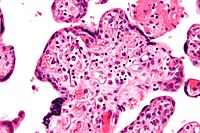
Photo from wikipedia
Objectives To investigate the postnatal growth trajectories of preterm infants and evaluate the association between extrauterine growth restriction (EUGR) at discharge and adverse physical growth outcomes at age 3–6 years.… Click to show full abstract
Objectives To investigate the postnatal growth trajectories of preterm infants and evaluate the association between extrauterine growth restriction (EUGR) at discharge and adverse physical growth outcomes at age 3–6 years. Methods Premature infants admitted to Shanghai Children’s Medical Center within 24 h after birth from 1 January 2016 to 31 December 2018 were enrolled. Neonatal complications, nutrition support, and anthropometric data were collected and analyzed to diagnose EUGR on different definitions at discharge. The weight and the height of each subject were collected by telephone investigation from 1 September 2021 to 31 November 2021 to access the incidences of overweight/obesity, short stature, and thinness at age 3–6 years. Results A total of 527 preterm infants were included in the final sample. The overall mean weight and height Z-scores were –0.37 ± 0.97 SD and –0.29 ± 1.18 SD at birth, and increased to –0.03 ± 1.11 SD and 0.13 ± 1.2 SD at follow-up, respectively. The logistic regression analysis indicated longitudinal EUGR on head circumference as the risk factor of overweight or obesity, cross-sectional EUGR on height as the risk factor of short stature, and delayed EN as the risk factor of thinness. Conclusion The growth trajectories of the preterm newborns tended toward the normal direction. Longitudinal EUGR on the head circumference and cross-sectional EUGR on height at discharge were associated with adverse physical growth outcomes at age 3–6 years.
Journal Title: Frontiers in Pediatrics
Year Published: 2022
Link to full text (if available)
Share on Social Media: Sign Up to like & get
recommendations!